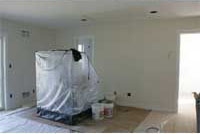Installations: The House That Jim Built Page 3
 |
| The plasma TV will go on the wall opposite the bed, between the bathroom and walk-in closet. |
The installers' practiced eyes also found several things I'd overlooked. For example, they pointed out that the living-room plasma TV needed a recessed clock outlet so the power cord wouldn't show, and that a stud below the TV had to be cut and framed to accommodate the horizontally mounted center-channel speaker.
While they were there, the installers also ran all the wires for the in-wall and ceiling speakers, and mounted cardboard templates on the studs so the dry-wallers would know exactly where to cut small holes for the wires to be pulled through. (I was going to leave the wires coiled in the walls and ceiling and hope my measurements were accurate enough to find them.)
If a little knowledge is a dangerous thing, I'd just found out the hard way that it can also be expensive. All told, it took the installers about 17 hours to pre-wire the addition, which at $100 an hour (rates vary by region and installer), came to $1,700. While that's not exactly chump change, in hindsight, it's a small price to pay compared to the cost, time, and aggravation of having to rip out sheetrock to correct the problem after the rooms were done.
In the next installment, Jim will discuss his equipment choices, the installation of the gear, deciding on a remote control to operate it all, and his plans for creating the home theater and recording studio in the basement.
House that Jim Built: Part Two Photo Gallery Back to Homepage What's New on S&V
- Log in or register to post comments























































